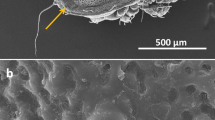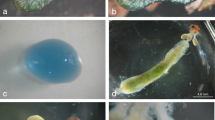Abstract
We compared the chemical compositions of the osmeterial secretions of fourth and fifth (last) instars of eight swallowtail species of the tribe Papilionini. Four species (Papilio demoleus, P. polytes, P. paris, and P. macilentus) are Asian Rutaceae-feeding swallowtails. The other four (Chilasa epicydes, C. agestor, P. troilus, and P. glaucus) represent more distant clades within the Papilionini and species with larval hosts in other plant families. We conducted a quantitative analysis for six species, but only qualitative analysis for P. glaucus and C. agestor. In all eight species, regardless of larval host plant, secretions of the fourth instar principally consisted of mono- and sesquiterpene hydrocarbons, whereas those of the fifth instar comprised aliphatic acids and their esters. Consistent with earlier findings, our results suggest that this “heterogeneous” pattern of osmeterial chemistry, not seen in other tribes, may characterize the Papilionini as a whole. Unlike those of most Papilio species, the fourth and fifth instars of Chilasa species resemble each other in body coloration. Thus, the heterogeneous osmeterial pattern is not necessarily associated with color change in papilionid larvae. The major terpenoids identified in fourth instar larval secretions from the six species were α-pinene, sabinene, β-myrcene, limonene, β-phellandrene, (Z)-β-ocimene, (E)-β-ocimene, p-mentha-1,4(8)-diene, β-elemene, β-caryophyllene, (E)-β-farnesene, (3Z,6E)-α-farnesene, (Z)-α-bisabolene, germacrene-A, (E)-α-bisabolene, and germacrene-B. The profiles for individual species differed both qualitatively and quantitatively from one another, and certain species also secreted methyl 3-hydroxy-n-butyrate and oxygenated sesquiterpenes in relatively large proportions. Secretions from fifth instars were composed of varying proportions of isobutyric, 2-methylbutyric, and acetic acids, and methyl and ethyl (minor) esters of both isobutyric and 2-methylbutyric acids. The heterogeneity of osmeterial chemistry in the tribe Papilionini may represent fine-tuning of chemical defense in response to shifting predation pressures as the larvae age and grow.

Similar content being viewed by others
References
Aldrich, J. R., Oliver, J. R., Oliver, J. E., Lusby, W. R., Kochansky, J. P., and Lockwood, J. A. 1987. Pheromone strains of the cosmopolitan pest, Nezara viridula (Heteroptera: Pentatomidae). J. Exp. Zool. 244:171–175.
Aldrich, J. R., Lusby, W. R., Marron, B. E., Nicolau, K. C., Hoffmann, M. P., and Wilson, L. T. 1989. Pheromone blends of green stink bugs and possible parasitoid selection. Naturwissenschaften 76:173–175.
Bengtsson, M., Bäckman, A.-C., Liblikas, I., Ramirez, M. I., Borg-Karlson, A.-K., Ansebo, L., Anderson, P., Löfqvist, J., and Witzgall, P. 2001. Plant odor analysis of apple: Antennal response of codling moth females to apple volatiles during phenological development. J. Agric. Food Chem. 49:3736–3741.
Berenbaum, M. R., Moreno, B., and Green, E. 1992. Soldier bug predation of swallowtail caterpillars: Circumvention of defensive chemistry. J. Insect Behav. 5:547–553.
Bernays, E. A. and Chapman, R. 1987. The evolution of deterrent responses in plant-feeding insects, pp. 159–173, in R. F. Chapman, E. A. Bernays, and J. G. Stoffolano (eds.). Perspectives in Chemoreception and Behavior. Springer-Verlag, New York.
Blum, M. S. 1981. Chemical Defenses of Arthropods. Academic Press, New York.
Brower, L. P. 1958. Bird predation and foodplant specificity in closely related procryptic insects. Amer. Natur. 92:183–187.
Brower, L. P. 1984. Chemical defence in butterflies, pp. 109–134, in R. I. Vane-Wright and P. R. Ackery (eds.). The Biology of Butterflies. Symp. R. Entomol. Soc. Lond., 11. Academic Press, London.
Burger, B. V., Munro, Z., Röth, M., Spies, H. S. C., Truter, V., Geertsema, H., and Habich, A. 1985. Constituents of osmeterial secretion of pre-final instars of citrus swallowtail, Papilio demodocus (Esper) (Lepidoptera: Papilionidae). J. Chem. Ecol. 11:1093–1113.
Chow, Y. S. and Tsai, R. S. 1989. Protective chemicals in caterpillar survival. Experientia 45:390–392.
Damman, H. 1986. The osmaterial glands of the swallowtail butterfly Eurytides marcellus as a defense against natural enemies. Ecol. Entomol. 11:261–265.
Eisner, T. and Meinwald, Y. C. 1965. Defensive secretion of a caterpillar (Papilio). Science 150:1733–1735.
Eisner, T., Pliske, T. E., Ikeda, M., Owen, D. F., Vázquez, L., Pérez, H., Franclemont, J. G., and Meinwald, J. 1970. Defense mechanisms of arthropods. XXVII. Osemeterial secretions of papilionid caterpillars (Baronia, Papilio, Eurytides). Ann. Entomol. Soc. Am. 63:914–915.
Eisner, T., Kluge, A. F., Ikeda, M. I., Meinwald, Y. C., and Meinwald, J. 1971. Sesquiterpenes in the osmeterial secretion of a papilionid butterfly, Battus polydamas. J. Insect Physiol. 17:245–250.
Feeny, P., Blau, W. S., and Kareiva, P. M. 1985. Larval growth and survivorship of the black swallowtail butterfly in Central New York. Ecol. Monogr. 55:167–187.
Gershenzon, J. and Croteau, R. 1991. Terpenoids, pp. 165–219, in G. A. Rosenthal and M. R. Berenbaum (eds.). Herbivores: Their Interaction with Secondary Plant Metabolites. Volume 1: The Chemical Participants, 2nd edition. Academic Press, San Diego, CA.
Hancock, D. L. 1983. Classification of the Papilionidae (Lepidoptera): A phylogenetic approach. Smithersia 2:1–48.
Harrewijn, P., Minks, A. K., and Mollema, C. 1995. Evolution of plant volatile production in insect–plant relationships. Chemoecology 5/6:55–73.
Hegnauer, R. 1971. Chemical patterns and relationships of Umbelliferae, pp. 267–277, in V. H. Heywood (ed.). The Biology and Chemistry of the Umbelliferae. Academic Press, London.
Hegnauer, R. 1983. Chemical characters and the classification of the Rutales, pp. 401–440, in P. G. Waterman and M. F. Grundon (eds.). Chemistry and Chemical Taxonomy of the Rutales. Academic Press, London.
Hirose, Y., Suzuki, Y., Takagi, M., Hiehata, K., Yamasaki, M., Kimoto, H., Yamanaka, M., Iga, M., and Yamaguchi, K. 1980. Population dynamics of the Citrus swallowtail, Papilio xuthus Linné (Lepidoptera: Papilionidae): Mechanisms stabilizing its numbers. Res. Popul. Ecol. 21:260–285.
Honda, K. 1980a. Osmeterial secretions of papilionid larvae in the genera Luehdorfia, Graphium and Atrophaneura (Lepidoptera). Insect Biochem. 10:583–588.
Honda, K. 1980b. Volatile constituents of larval osmeterial secretions in Papilio protenor demetrius. J. Insect Physiol. 26:39–45.
Honda, K. 1981. Larval osmeterial secretions of the swallowtail (Papilio). J. Chem. Ecol. 7:1089–1113.
Honda, K. 1983a. Defensive potential of components of the larval osmeterial secretion of papilionid butterflies against ants. Physiol. Entomol. 8:173–179.
Honda, K. 1983b. Evidence for de novo biosynthesis of osmeterial secretions in young larvae of the swallowtail butterflies (Papilio): Deuterium incorporation in vivo into sesquiterpene hydrocarbons as revealed by mass spectrometry. Insect Sci Appl. 4:255–261.
Honda, K. 1990. GC-MS and 13C-NMR studies on the biosynthesis of terpenoid defensive secretions by the larvae of papilionid butterflies (Luehdorfia and Papilio). Insect Biochem. 20:245–250.
Honda, K. and Hayashi, N. 1995. Chemical nature of larval osmeterial secretions of papilionid butterflies in the genera Parnassius, Sericinus and Pachliopta. J Chem. Ecol. 21:859–867.
Igarashi, S. 1979. Papilionidae and Their Early Stages. Kodansha, Tokyo, Japan.
Igarashi, S. 1984. The classification of the Papilionidae mainly based on the morphology of their immature stages. Trans. Lepid. Soc. Jpn. 34:41–96.
Järvi, T., Sillén-Tullberg, B., and Wiklund, C. 1981. The cost of being aposematic. An experimental study of predation on larvae of Papilio machaon by the great tit Parus major. Oikos 36:267–272.
Leslie, A. J. and Berenbaum, M. R. 1990. Role of the osmeterial gland in swallowtail larvae (Papilionidae) in defense against an avian predator. J. Lep. Soc. 44:245–251.
Lopez, A. and Quesnel, V. C. 1970. Defensive secretions of some papilionid caterpillars. Carib. J. Sci. 10:5–7.
Miller, J. S. 1987. Phylogenetic studies in the Papilioninae (Lepidoptera: Papilionidae). Bull. Am. Nat. Hist. 186:365–512.
Munroe, E. and Ehrlich, P. R. 1960. Harmonization of concepts of higher classification of the Papilionidae. J. Lepidop. Soc. 14:169–175.
Nigg, H. N., Mallory, L. L., Simpson, S. E., Callaham, S. B., Toth, J. P., Fraser, S., Klim, M., Nagy, S., Nation, J. L., and Attaway, J. A. 1994. Caribbean fruit fly, Anastrepha suspense (Loew), attraction to host fruit and host kairomones. J. Chem. Ecol. 20:727–743.
Nishida, R. 1995. Sequestration of plant secondary compounds by butterflies and moths. Chemoecology 5/6:127–138.
Nishida, R. and Fukami, H. 1989. Ecological adaptation of an Aristolochiaceae-feeding swallowtail butterfly, Atrophaneura alcinous, to aristolochic acids. J. Chem. Ecol. 15:2549–2563.
Nishida, R., Weintraub, J. D., Feeny, P., and Fukami, H. 1993. Aristolochic acids from Thottea spp. (Aristolochiaceae) and the osmeterial secretions of Thottea-feeding troidine swallowtail larvae (Papilionidae). J. Chem. Ecol. 19:1587–1594.
Reavey, D. 1993. Why body size matters to caterpillars, pp. 248–279, in N. E. Stamp and T. M. Casey (eds.). Caterpillars: Ecological and Evolutionary Constraints on Foraging. Chapman and Hall, New York.
Scriber, J. M. 1995. Overview of swallowtail butterflies: taxonomic and distributional latitude, pp. 3–8, in J. M. Scriber, Y. Tsubaki, and R. C. Lederhouse (eds.). Swallowtail Butterflies: Their Ecology and Evolutionary Biology. Scientific Publishers, Gainesville, FL.
Seligman, I. M. and Doy, F. A. 1972. β-Hydroxy-n-butyric acid in the defensive secretion of Papilio aegeus. Comp. Physiol. 41:341–342.
Seligman, I. M. and Doy, F. A. 1973. Biosynthesis of defensive secretions in Papilio aegeus. Insect Biochem. 3:205–215.
Sime, K. R. 2002. Chemical defence of Battus philenor larvae against attack by the parasitoid Trogus pennator. Ecol. Entomol. 27:337–345.
Sime, K. R., Feeny, P. P., and Haribal, M. M. 2000. Sequestration of aristolochic acids by the pipevine swallowtail, Battus philenor (L.): Evidence and ecological implications. Chemoecology 10:169–178.
Stamp, N. E. 1986. Physical constraints of defense and response to invertebrate predators by pipevine caterpillars (Battus philenor: Papilionidae). J. Lepidop. Soc. 40:191–205.
Takagi, M., Hirose, Y., and Yamasaki, M. 1995. Antipredator defense in Papilio larvae: effective or not? pp. 85–92, in J. M. Scriber, Y. Tsubaki, and R. C. Lederhouse (eds.). Swallowtail Butterflies: Their Ecology and Evolutionary Biology. Scientific Publishers, Gainesville, FL.
Watanabe, M. 1981. Population dynamics of the swallowtail butterfly, Papilio xuthus L., in a deforested area. Res. Popul. Ecol. 23:74–93.
Young, A. M. 1973. Notes on the life cycle and natural history of Parides arcas mylotes (Papilionidae) in Costa Rican premontane wet forest. Psyche 80:1–21.
Young, A. M., Blum, M. S., Fales, H. M., and Bian, Z. 1986. Natural history and ecological chemistry of the neotropical butterfly Papilio anchisiades (Papilionidae). J. Lepidop. Soc. 40:36–53.
Zakharov, E. V., Caterino, M. S., and Sperling, F. A. H. 2004. Molecular phylogeny, historical biogeography, and divergence time estimates for swallowtail butterflies of the genus Papilio (Lepidoptera: Papilionidae). Syst. Biol. 53:193–215.
Acknowledgments
We thank Y. Zhang for collecting samples from C. epycides, C. agestor, P. demoleus, and P. paris. We also thank A. Agrawal, A. Kessler, and F. Sperling for helpful discussion.
Author information
Authors and Affiliations
Corresponding author
Rights and permissions
About this article
Cite this article
Ômura, H., Honda, K. & Feeny, P. From Terpenoids to Aliphatic Acids: Further Evidence for Late-Instar Switch in Osmeterial Defense as a Characteristic Trait of Swallowtail Butterflies in the Tribe Papilionini. J Chem Ecol 32, 1999–2012 (2006). https://doi.org/10.1007/s10886-006-9124-x
Received:
Revised:
Accepted:
Published:
Issue Date:
DOI: https://doi.org/10.1007/s10886-006-9124-x




